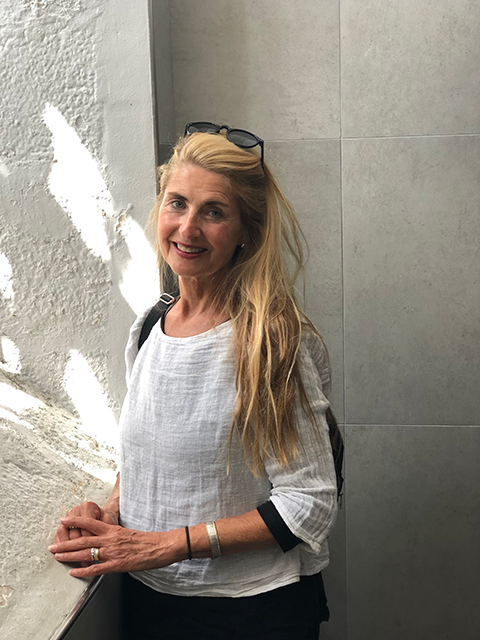
Linda Keane (Professor)

What did you aspire to be growing up?
An athlete, a jockey, a pilot, a veterinarian, an artist, and then an architect.
What’s the first thing you do when you wake up?
I look at the sky, I look at the lake, I look at the land. Then I let the dogs out.
What do you consider to be your greatest achievement?
Understanding and respecting that everything and everyone is connected.
Do you have a secret talent that has influenced your practice in some way?
I am an ambivert. As much as I love architecture and cities, I am happier exploring outside where I best appreciate silence.
What historical figures or cultural icons inspire you?
Jacques Cousteau, Fritjof Capra, David Orr, Eleanor Roosevelt, E.E.Cummings, Theodore Roosevelt, Frederic Law Olmstead, Le Corbusier, FLWright, Louis Kahn, Richard Saul Wurman, Renzo Piano, Norman Foster, Ricardo Burle Marx, Carmé Pinos, Jan Gehl, Bjarke Ingals; My grandparents and parents, children, community, clients, friends, students, peers and mentors in architecture and education, the intellectual academic family of The School of the Art Institute of Chicago, and the life of plants, trees, birds, insects, animals, fish, amphibians of the out of doors. In addition, people, friends, and professionals from all over the world.
Do you identify with a piece of music of lyricist?
It totally depends on if I am running, driving, thinking, writing, drawing, or having people over. Beethoven, Bach, Handel, Mozart, Mahler, Respighi, Strauss, Vivaldi, in between Coldplay, Radiohead, Crosbie, Stills, Nash & Young, Cat Stevens, and Queen.
What or who inspired you when you were a student?
In environmental design I studied under a landscape architect in England and learned to think from the land’s point of view.
What strategies did you use to be successful in college?
I read Columbia’s freshman reading list before I went. I lived on ice cream, chocolate, and coffee. I was interested in everything. I graduated at the top of my class. I drove north, south, east, and west across the US with my dog. Then I lived in Paris, London, and Istanbul.
What written piece of criticism or fiction has motivated you?
Writings from different cultures and different periods of history--legends, philosophies, treatises, mythologies, and theories. I am always reading and listening to podcasts.
How would you describe your teaching style?
It is joyous because it is always exploring the world, that is, for the world that could be with new imaginations. I thrive at looking at the world from different perspectives to better envision a new future. I try to work as hard as the students. I stay in touch with them as they design their life.
What are some of your most memorable moments teaching?
My class interviewing Philip Johnson in his office in the Seagram’s building. That left me standing with him as my students ran to look out the windows, never having been in a skyscraper before.
How does your teaching practice influence your practice as a designer/architect/interior architect?
I consider it an incredible freedom and honor to research new fields and envision what could be, but does not yet exist.
What are a couple of your favorite stories of former students?
Thomas Kerwin of BKL and Thomas Powers of IA Architects once had a beginning studio in which they raised chickens (with 80 other students doing the same) from an egg to four weeks old, building environments, protecting their health, safety, and welfare during a Midwest blizzard. We called it Chick Chick Chick and it was hysterical mayhem.
Jeff Bone of Landon Bone Baker was my first employee when I opened my office in Muncie, IN. With two other architecture grads we spent a summer designing a 50,000 sf campus for special needs children, adults, and their families as a place of pride and community helping each person reach their own potential. Instead of Anderson County for Retarded People, we got the name changed to Hopewell Center (after the Native people who originally lived there) for People with Disabilities. And instead of one large building, we created a colonnaded campus with a house for living skills at its center.
Why did you decide to enter your field?
To connect people to the places in which they live, work, learn, and play with purpose and potential.
Describe the city of the future.
It is a city that is for children. Childhood is everything to the imagination. It is beautiful. It has places for everyone to prosper.
What is the future of design/architecture/interior architecture?
The second skin of the earth holds all that we are and all that the earth offers. It’s our health and our future. Short and medium range goals need to be measured against long term goals in lessening our impact.
What are the most urgent questions facing design/architecture/interior architecture today?
Almost everything needs to be redesigned, but now we are aware of our impact. How can design better support human life, create places of beauty and meaning?
Learn more about Linda Keane here.
